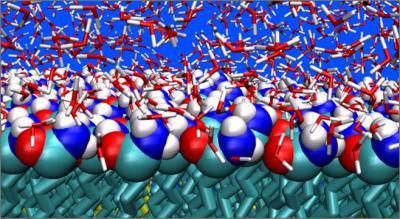Laying Microscale Tiles
Microcrystalline monolayers: Laying by hand is superior to self-assembly methods
Craftsmen tile walls or floors by hand; but how can you get an ordered monolayer onto a substrate when the "tiles" are microscopically small instead of big and easy to handle? Previously, self-assembly processes have been the method of choice for this scale. Korean researchers have now come to the realization that even such tiny components can be arranged in a "do-it-yourself" method. As they describe in the journal Angewandte Chemie, their manually produced monolayers of microcrystals are qualitatively superior to the self-assembled variety.
How small can components be such that they can still be glued to a surface by hand? And conversely, how big can microscale components be such that they can still be arranged by self-assembly? Which method is best in the size range in which both techniques work? These questions have been investigated by a team led by Kyung Byung Yoon at Sogang University in Seoul. To find answers, they carried out experiments with variously sized zeolite crystals. Zeolites are aluminosilicate minerals with a wide range of applications in many technical fields.
The powdered zeolite was applied by simply rubbing it on with a finger (with and without wearing a latex glove). Alternatively, they were applied in solution, and ultrasound was used to kick-start the self-assembly process. The "glue" between the "mini-tiles" and the substrate was the attraction between oppositely charged groups of atoms, hydrogen bonds, and chemical bonds between reactive groups of atoms.
The experiments demonstrated that self-assembly only works for particles smaller than about 3 µm. Hand-application works for crystals as small as 0.5 µm in diameter. In the overlapping range (0.5 to 3 µm), hand application is preferable to self-assembly for quality: the packing is denser and the microcrystals are oriented more regularly. Whereas self-assembly produces individual crystals grown at a 90° angle onto the monolayer, such "parasites" are simply rubbed off by hand. There are other "handy" advantages of the manual process as well: it is simpler, doesn't require a solvent or special equipment, runs more smoothly, and allows treatment of larger surfaces.
Originalveröffentlichung: Kyung Byung Yoon et al.; "Manual Assembly of Microcrystal Monolayers on Substrates"; Angewandte Chemie International Edition 2007, 46, No. 17.
Most read news
Organizations

Get the analytics and lab tech industry in your inbox
By submitting this form you agree that LUMITOS AG will send you the newsletter(s) selected above by email. Your data will not be passed on to third parties. Your data will be stored and processed in accordance with our data protection regulations. LUMITOS may contact you by email for the purpose of advertising or market and opinion surveys. You can revoke your consent at any time without giving reasons to LUMITOS AG, Ernst-Augustin-Str. 2, 12489 Berlin, Germany or by e-mail at revoke@lumitos.com with effect for the future. In addition, each email contains a link to unsubscribe from the corresponding newsletter.























































